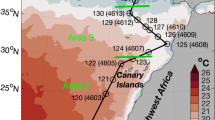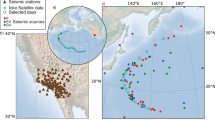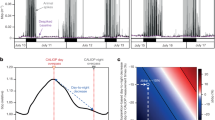Abstract
LIGHT and temperature are considered to be the factors that influence did vertical migrations of populations of biological sound scatterers (deep scattering layers) in the sea1–3. While light is probably the most important, temperatures which surpass the physiological tolerances of the organisms should play a major role in setting vertical limits. With positive thermal gradients (temperature increasing with depth) as are found in arctic and sub-arctic seas, sufficiently low temperatures near the surface could limit the evening ascent. This situation was observed in March, 1966 over the Kurile Trench along the eastern coast of the Kamchatka Peninsula (50°30′N, 162°30′E), an area influenced by the Oya Shio current system. Data were collected from USNS Charles Davis; acoustic records were made on a Westrex MK 10A Precision Depth Recorder using a Gifft transceiver to drive a hull-mounted UQN transducer at 12kHz. The records were made on the 1.5-s sweep scale of the recorder.
This is a preview of subscription content, access via your institution
Access options
Subscribe to this journal
Receive 51 print issues and online access
$199.00 per year
only $3.90 per issue
Buy this article
- Purchase on Springer Link
- Instant access to full article PDF
Prices may be subject to local taxes which are calculated during checkout
Similar content being viewed by others
References
Kampa, E. M., and Boden, B. P., Nature, 174, 869–871 (1954).
Clarke, G. L., and Backus, R. H., Deep Sea Res., 4, 1–14 (1956).
Moore, H. B., Marine Ecology (Wiley, New York, 1958).
Hersey, J. B., and Backus, R. H., in The Sea, 1 (edit. by Hill, M. N.), 498–539 (Wiley, New York, 1962).
Cushing, D. H., Lee, A. J., and Richardson, I. D., J. mar. Res., 15, 1–13 (1956).
Weston, D. E., Deep Sea Res., 5, 44–50 (1958).
Author information
Authors and Affiliations
Rights and permissions
About this article
Cite this article
DAVIES, I. Arrest of deep scattering layer migration by a positive thermal gradient. Nature 260, 599–600 (1976). https://doi.org/10.1038/260599a0
Received:
Accepted:
Issue Date:
DOI: https://doi.org/10.1038/260599a0
Comments
By submitting a comment you agree to abide by our Terms and Community Guidelines. If you find something abusive or that does not comply with our terms or guidelines please flag it as inappropriate.



